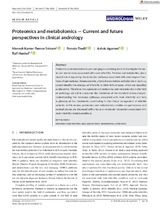| dc.contributor.author | Henkel, R | |
| dc.contributor.author | Baskaran, S | |
| dc.contributor.author | Finelli, R | |
| dc.date.accessioned | 2021-05-11T11:59:23Z | |
| dc.date.available | 2021-05-11T11:59:23Z | |
| dc.date.issued | 2021 | |
| dc.identifier.citation | Henkel, R. et al. (2021). Diagnostic value of routine semen analysis in clinical andrology. Andrologia, 53(2),e13614 | en_US |
| dc.identifier.issn | 0303-4569 | |
| dc.identifier.uri | 10.1111/and.13614 | |
| dc.identifier.uri | http://hdl.handle.net/10566/6139 | |
| dc.description.abstract | Infertility is a major health issue affecting over 48.5 million couples around the world, with the male factor accounting for about 50% of the cases. The conventional semen analysis recommended by the World Health Organization (WHO) is the cornerstone in the evaluation of male fertility status. It includes macroscopic and microscopic evaluation of the ejaculate, which reflects the production of spermatozoa in the testes, the patency of the duct system and the glandular secretory activity. Evaluation of seminal fructose, sperm vitality and leucocytes (Endtz test) are useful adjuncts to semen analysis that provide information on specific clinical conditions. Though several computer-assisted sperm analysis (CASA) systems have been developed, conventional methods for semen analysis are still widely accepted in clinical practice. This review summarises the conventional techniques used in routine semen analysis and their diagnostic value in clinical andrology. | en_US |
| dc.language.iso | en | en_US |
| dc.publisher | Blackwell Publishing Ltd | en_US |
| dc.subject | Diagnostic value | en_US |
| dc.subject | Male infertility | en_US |
| dc.subject | Semen | en_US |
| dc.subject | Spermatozoa | en_US |
| dc.title | Diagnostic value of routine semen analysis in clinical andrology | en_US |
| dc.type | Article | en_US |

